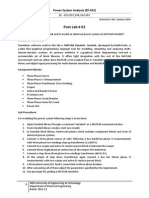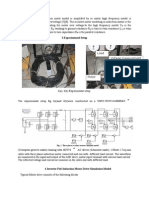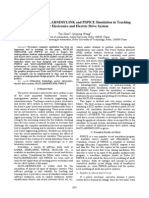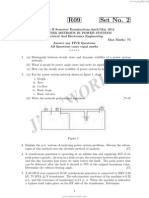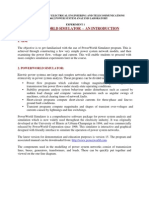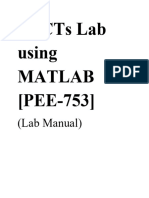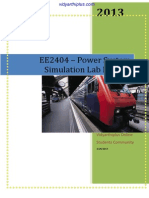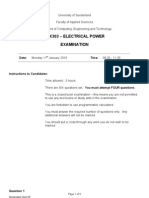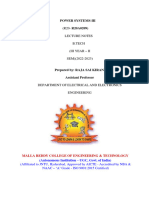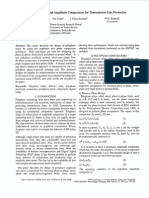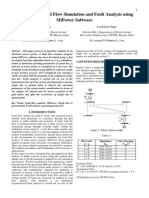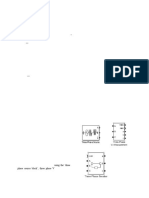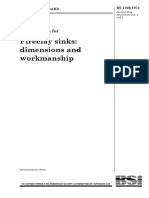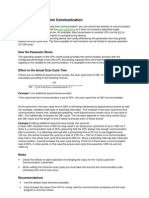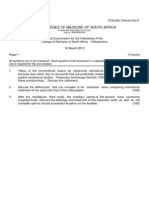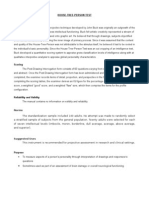0 ratings0% found this document useful (0 votes)
37 viewsChapter 6:simulation of Power Quality Disturbance Using Simulink and Power Quality Analysis Using Wavelet Transform
Chapter 6:simulation of Power Quality Disturbance Using Simulink and Power Quality Analysis Using Wavelet Transform
Uploaded by
Sarmila Patra1) The document describes Simulink models for simulating power quality disturbances including sags, swells, and harmonics.
2) A model is presented that simulates a single line-to-ground fault causing a sag, with the voltage waveform and energy deviation curve shown.
3) Another model simulates a universal bridge causing harmonics, with the distorted voltage waveform and corresponding energy deviation curve presented.
Copyright:
© All Rights Reserved
Available Formats
Download as PDF, TXT or read online from Scribd
Chapter 6:simulation of Power Quality Disturbance Using Simulink and Power Quality Analysis Using Wavelet Transform
Chapter 6:simulation of Power Quality Disturbance Using Simulink and Power Quality Analysis Using Wavelet Transform
Uploaded by
Sarmila Patra0 ratings0% found this document useful (0 votes)
37 views9 pages1) The document describes Simulink models for simulating power quality disturbances including sags, swells, and harmonics.
2) A model is presented that simulates a single line-to-ground fault causing a sag, with the voltage waveform and energy deviation curve shown.
3) Another model simulates a universal bridge causing harmonics, with the distorted voltage waveform and corresponding energy deviation curve presented.
Original Description:
power quality
Original Title
prj ch6
Copyright
© © All Rights Reserved
Available Formats
PDF, TXT or read online from Scribd
Share this document
Did you find this document useful?
Is this content inappropriate?
1) The document describes Simulink models for simulating power quality disturbances including sags, swells, and harmonics.
2) A model is presented that simulates a single line-to-ground fault causing a sag, with the voltage waveform and energy deviation curve shown.
3) Another model simulates a universal bridge causing harmonics, with the distorted voltage waveform and corresponding energy deviation curve presented.
Copyright:
© All Rights Reserved
Available Formats
Download as PDF, TXT or read online from Scribd
Download as pdf or txt
0 ratings0% found this document useful (0 votes)
37 views9 pagesChapter 6:simulation of Power Quality Disturbance Using Simulink and Power Quality Analysis Using Wavelet Transform
Chapter 6:simulation of Power Quality Disturbance Using Simulink and Power Quality Analysis Using Wavelet Transform
Uploaded by
Sarmila Patra1) The document describes Simulink models for simulating power quality disturbances including sags, swells, and harmonics.
2) A model is presented that simulates a single line-to-ground fault causing a sag, with the voltage waveform and energy deviation curve shown.
3) Another model simulates a universal bridge causing harmonics, with the distorted voltage waveform and corresponding energy deviation curve presented.
Copyright:
© All Rights Reserved
Available Formats
Download as PDF, TXT or read online from Scribd
Download as pdf or txt
You are on page 1of 9
Chapter 6:Simulation of Power Quality Disturbance using Simulink and
Power Quality Analysis using Wavelet Transform
6.1 Introduction
Simulink is a visual simulation tool of Matlab; it can be used in the simulation of power system
and power electronics device. Simulink is a software package for modeling, simulating, and
analyzing dynamical systems. It supports linear and nonlinear systems, modeled in continuous
time, sampled time, or a hybrid of the two. Systems can also be multirate, i.e., have different
parts that are sampled or updated at different rates.
For modeling, Simulink provides a graphical user interface (GUI) for building models as block
diagrams, using click-and-drag mouse operations. With this interface, one can draw the models
just as one would with pencil and paper (or as most textbooks depict them). This is a far cry from
previous simulation packages that require to formulate differential equations and difference
equations in a language or program. Simulink includes a comprehensive block library of sinks,
sources, linear and nonlinear components, and connectors. We can also customize and create our
own blocks.
6.2 The Power System Blockset in Simulink
The Power System Blockset allows scientists and engineers to build models that simulate power
systems. The blockset uses the Simulink environment, allowing a model to be built using click
and drag procedures. Not only can the circuit topology be drawn rapidly, but the analysis of the
circuit can include its interactions with mechanical, thermal, control, and other disciplines. This
is possible because all the electrical parts of the simulation interact with Simulinks extensive
modeling library. Because Simulink usesMATLAB as the computational engine, MATLABs
toolboxes can also be used by the designer. The blockset libraries contain models of typical
power equipment such as transformers, lines, machines, and power electronics.
powergui
Continuous
Voltage Measurement
v
+
-
Three-Phase Source
N
A
B
C
Three-Phase Fault
A
B
C
A
B
C
Three-Phase
V-I Measurement
Vabc
Iabc
A
B
C
a
b
c
Signal To
Workspace1
sig1
Signal To
Workspace
sig
Series RLC Branch 2
Series RLC Branch 1
Series RLC Branch
Scope5
Scope4
Scope3
Scope2
Scope1
Scope
Multimeter1
1
Multimeter
3
Distributed Parameters Line 1
Distributed Parameters Line
6.2.1 Simulink Model 1 for Power Quality Distubance (Sag and Swell):
Fig 6.1 The simulink model
The above model is designed in Simulink using the Power system Blockset.
Block Parameter
Three phase source in series with R-L branch Phase to Phase rms voltage=380V
Phase angle of phase A=0degree
Frequency=50 Hertz
Source Resistance=.001 Ohm
Source Inductance=16.58 mH
Three phase VI measurement Phase to ground voltage measurement
Base voltage=380 V
Distributed parameter line No of phase=3
Frequency=50 Hertz
Line length=40 km
Distributed parameter line1 No of phase=3
Frequency=50 Hertz
Line length=40 km
0 500 1000 1500 2000 2500 3000
-300
-200
-100
0
100
200
300
0 0.05 0.1 0.15 0.2 0.25 0.3 0.35
-200
0
200
Ub: Three-Phase Fault/Fault A
0 0.05 0.1 0.15 0.2 0.25 0.3 0.35
-200
0
200
Ub: Three-Phase Fault/Fault B
0 0.05 0.1 0.15 0.2 0.25 0.3 0.35
-200
0
200
Ub: Three-Phase Fault/Fault C
Series RL branch R=10 ohm
L=.005 H
Voltage measurement Type ideal
Table 6.1 Table of blocks used in Simulink model
6.3 Generation of fault and its Simulation Results
A single line to ground fault is generated at phase A between the two distributed parameter lines
between .11 to .15 second. Simulation time is .35 second.
Figure 6.2 shows the voltage waveform at fault point.
Fig 6.2 Voltage waveform at fault point
Fig 6.3 Voltage of Phase A in power side in single phase earthing fault(Sag)
Figure 6.3 shows voltage of phase A in power side in single phase earthing fault. The disturbance
type is Sag.
Figure 6.4 shows voltage of phase b in power side. The disturbance type is swell.
Fig 6.4 Voltage of phase B at power side (Swell)
The voltage waveform at phase A at power side is distorted. The disturbance type is sag. This
waveform is sent to workspace for analysis. Its energy deviation is calculated by using wavelet
coefficient. The voltage at phase B at power side is also distorted. The disturbance type is swell.
This waveform is also sent to workspace for analysis. Its energy deviation curve is also plotted in
figure 6.5.
0 500 1000 1500 2000 2500 3000
-250
-200
-150
-100
-50
0
50
100
150
200
250
Final Result:
Fig 6.5:Energy Deviation Curve for Sag
powergui
Continuous
Universal Bridge
A
B
C
+
-
Three-Phase Source
A
B
C
Three-Phase
V-I Measurement
Vabc
Iabc
A
B
C
a
b
c
Signal To
Workspace
harm
Series RLC Branch
Scope6
Scope5
Scope4
Scope3
Scope2
Scope1
Scope
Distributed Parameters Line
Current Measurement
i
+
-
Fig 6.6 Energy deviation for swell
6.2.2 Simulink Model 2 for Harmonic Disturbance
1 2 3 4 5 6 7 8 9 10
0
0.5
1
1.5
2
2.5
3
3.5
x 10
7
The above model is designed in Simulink using Power system blockset.
Block Parameter
3 phase source Phase Rms voltage=380 V
Frequency=50 Hertz
Source resistance=.8929 Ohm
Source inductance=.001658 Henry
3 phase VI measurement Voltage measurement- phase to ground
Base voltage=380 V
Distributed parameter line Line length=40 km
Current measurement
Universal bridge
Type ideal
Number of bridge arms=3
Snubber resistance=500 Ohm
Snubber capacitance=infinity
Power electronics device used-diode
Ron=20 Ohm
Lon=0 H
Table 6.2 Table of blocks used
With the wide application of various power electronic devices, they bring harmonic and
interharmonic pollution into the power system. Here the universal bridge is taken as the Power
Electonic device.
0 500 1000 1500 2000 2500 3000 3500 4000 4500 5000
-1.5
-1
-0.5
0
0.5
1
1.5
Simulation Result:
Ode23tb is selected as simulation algorithm and .35 second is selected as simulation time.
Fig 6.7 Voltage of phase A power side
This distorted waveform is sent to workspace for analysis. Its energy deviation is calculated.
Final Result:
Fig 6.8 Energy Deviation curve for Harmonic
You might also like
- CES Wrong Answer Summary-1Document2 pagesCES Wrong Answer Summary-1Владислав Комаров100% (2)
- Method Statement - ASPHALT CONCRETE WORKS PDFDocument10 pagesMethod Statement - ASPHALT CONCRETE WORKS PDFTAHER AMMAR100% (7)
- The Short Victorious WarDocument232 pagesThe Short Victorious Warmocha_volfgong100% (2)
- Digital Simulation of Power Systems and Power Electronics Using The MATLAB-Simulink Power System BlocksetDocument10 pagesDigital Simulation of Power Systems and Power Electronics Using The MATLAB-Simulink Power System Blocksetehoangvan100% (1)
- (Doi 10.1201/9781315316246-2) Perelmuter, Viktor - Renewable Energy Systems (Simulation With Simulink® and SimPowerSystems™) - Chapter 1 SimPowerSystems™ ModelsDocument14 pages(Doi 10.1201/9781315316246-2) Perelmuter, Viktor - Renewable Energy Systems (Simulation With Simulink® and SimPowerSystems™) - Chapter 1 SimPowerSystems™ ModelsTheodore Teddy J100% (1)
- Matlab ManualDocument50 pagesMatlab ManualRavi AnandNo ratings yet
- Inversor Trifasico en MatlabDocument6 pagesInversor Trifasico en MatlabAngel Arturo Castellanos SantamariaNo ratings yet
- Fault Detection and Classification Using Machine Learning in MATLABDocument6 pagesFault Detection and Classification Using Machine Learning in MATLABlaksh sharma100% (1)
- Dist RelayDocument6 pagesDist RelaymakroumNo ratings yet
- Manual EE303Document38 pagesManual EE303Anupam Adarsh KumarNo ratings yet
- Electrical Power System Model On MATLAB SimulinkDocument2 pagesElectrical Power System Model On MATLAB Simulinkaalamz93_854917254100% (2)
- Power System Analysis and Simulation Question PaperDocument2 pagesPower System Analysis and Simulation Question PaperKeyur Patel100% (1)
- Simulink Design of Three Phase Fault DetectionDocument8 pagesSimulink Design of Three Phase Fault DetectionNishant NagarNo ratings yet
- 7.short Circuit CalculationsDocument14 pages7.short Circuit Calculationskvramanan_1No ratings yet
- Solar Powered Simplified Multilevel InverterDocument8 pagesSolar Powered Simplified Multilevel InverterAnney RevathiNo ratings yet
- Three Phase Full-Wave Rectifier-1Document6 pagesThree Phase Full-Wave Rectifier-1Abrahem SawlanNo ratings yet
- Electrical Engineering Department, National Institute of Technology Calicut Year 2004Document4 pagesElectrical Engineering Department, National Institute of Technology Calicut Year 2004Nirmal mehtaNo ratings yet
- Methodology HifiDocument6 pagesMethodology HifikrcdewanewNo ratings yet
- Getting Started With Power System BlocksetDocument33 pagesGetting Started With Power System BlocksetIrfan AliNo ratings yet
- Application of MATLAB SIMULINK and PSPICE Simulation in Teaching Power Electronics and Electric Drive SystemDocument5 pagesApplication of MATLAB SIMULINK and PSPICE Simulation in Teaching Power Electronics and Electric Drive SystemRaghava Katreepalli0% (1)
- Power Electronics Lab Assignment-XII: ObjectiveDocument7 pagesPower Electronics Lab Assignment-XII: ObjectiveKASHIF zamanNo ratings yet
- Simpower TaskDocument9 pagesSimpower TaskFahad SaleemNo ratings yet
- Computer Methods in Power SystemsDocument7 pagesComputer Methods in Power SystemssuhrudkumarNo ratings yet
- ELEC4612-11 Exp 1 IntroductionDocument6 pagesELEC4612-11 Exp 1 IntroductionJoseph MouNo ratings yet
- Power System Analysis Max. Marks: 30 Branch/Sem:En-Vi Time: 2 HrsDocument2 pagesPower System Analysis Max. Marks: 30 Branch/Sem:En-Vi Time: 2 HrsVikash TiwariNo ratings yet
- Build and Simulate A Simple CircuitDocument5 pagesBuild and Simulate A Simple Circuitf789sgacanonNo ratings yet
- Pee753 - Lab MaualDocument35 pagesPee753 - Lab MaualParth UpadhyayNo ratings yet
- Dynamic Improvement of Induction Generators Connected To Distribution Systems Using A DstatcomDocument5 pagesDynamic Improvement of Induction Generators Connected To Distribution Systems Using A DstatcomVinod Kumar VudathaNo ratings yet
- Impact of Auto Reclosing Scheme On Distribution NetworksDocument4 pagesImpact of Auto Reclosing Scheme On Distribution NetworkshaminhomanNo ratings yet
- CBPSDDocument55 pagesCBPSDNimisha GoyalNo ratings yet
- LOGBOOKDocument29 pagesLOGBOOKAakash SinghNo ratings yet
- PTD Exp 1-4Document19 pagesPTD Exp 1-4Anupam Adarsh KumarNo ratings yet
- POWER SYSTEM ANALYSIS_UNIVERSITY QUESTIONSDocument92 pagesPOWER SYSTEM ANALYSIS_UNIVERSITY QUESTIONSvasantht2005tNo ratings yet
- Eee Sem 7 Ee2404lmDocument36 pagesEee Sem 7 Ee2404lmAnonymous gAVMpR0aNo ratings yet
- Impulse Voltage Generator Modelling Using MATLABDocument7 pagesImpulse Voltage Generator Modelling Using MATLABKsr AkhilNo ratings yet
- Arc ModelDocument5 pagesArc Modelbinoy_ju07No ratings yet
- EDSA UNIT 3Document49 pagesEDSA UNIT 3dueltmpqajgpNo ratings yet
- EPS 2 Tut1Document7 pagesEPS 2 Tut1Deep ShethNo ratings yet
- Asya Baş - İdil Gürsoy - Nehir Huriye Öztürk PDFDocument7 pagesAsya Baş - İdil Gürsoy - Nehir Huriye Öztürk PDFasyabas03No ratings yet
- Short Circuit Fault Analysis of Electrical Power System Using MATLABDocument12 pagesShort Circuit Fault Analysis of Electrical Power System Using MATLABInternational Organization of Scientific Research (IOSR)100% (3)
- Asya Baş - İdil Gürsoy - Nehir Huriye Öztürk PDFDocument8 pagesAsya Baş - İdil Gürsoy - Nehir Huriye Öztürk PDFasyabas03No ratings yet
- PSA LAB 7-1abdullahDocument7 pagesPSA LAB 7-1abdullahabdullahrasheed12764No ratings yet
- Harmonic Reduction in Three-Phase ParallelDocument6 pagesHarmonic Reduction in Three-Phase ParallelAhmed JanadNo ratings yet
- Power Electronics Lab Assignment-XI: Simulation of Full Bridge InverterDocument5 pagesPower Electronics Lab Assignment-XI: Simulation of Full Bridge InverterKASHIF zamanNo ratings yet
- CAPS Lab ManualDocument18 pagesCAPS Lab ManualAyush NemaNo ratings yet
- 13 PDFDocument4 pages13 PDFEBENo ratings yet
- Elx303 ExamDocument5 pagesElx303 ExamNadeesha BandaraNo ratings yet
- PSM Lab6Document14 pagesPSM Lab6ASHUTOSHNo ratings yet
- Harmonic Analysis of Three Phase PWM Inverter Systems Using MatlabDocument8 pagesHarmonic Analysis of Three Phase PWM Inverter Systems Using Matlabturbo385No ratings yet
- Power Systems-III Ditital NotesDocument102 pagesPower Systems-III Ditital NotesSimranNo ratings yet
- Design Phase and Amplitude Comparators For Transmission Line ProtectionDocument6 pagesDesign Phase and Amplitude Comparators For Transmission Line ProtectionKaran Bir SinghNo ratings yet
- MW Scas 2008Document4 pagesMW Scas 2008pk27575No ratings yet
- Simulation of Some Power System, Control System and Power Electronics Case Studies Using Matlab and PowerWorld SimulatorFrom EverandSimulation of Some Power System, Control System and Power Electronics Case Studies Using Matlab and PowerWorld SimulatorNo ratings yet
- Modellinag & Simulation With MiPowerDocument5 pagesModellinag & Simulation With MiPowerAkshay SharmaNo ratings yet
- Improved Power Quality For Renewable Power Generation Systems Presence of Non-Linear LoadsDocument6 pagesImproved Power Quality For Renewable Power Generation Systems Presence of Non-Linear LoadsPhanikumar Bellam KondaNo ratings yet
- MATLAB LAB ManualDocument36 pagesMATLAB LAB Manuals sivaNo ratings yet
- Power Systems QuestionsDocument45 pagesPower Systems Questionssamg27No ratings yet
- Designofanovercurrentrelayusing MATLABSimulinkDocument4 pagesDesignofanovercurrentrelayusing MATLABSimulinkIkshore SinghNo ratings yet
- Simulation of Electric Machinery and Power Electronics InterfacingDocument6 pagesSimulation of Electric Machinery and Power Electronics Interfacingadilo7780No ratings yet
- PSP 253Document109 pagesPSP 253Vasudevareddy ThalamatiNo ratings yet
- Advanced Control of AC / DC Power Networks: System of Systems Approach Based on Spatio-temporal ScalesFrom EverandAdvanced Control of AC / DC Power Networks: System of Systems Approach Based on Spatio-temporal ScalesNo ratings yet
- Design of Electrical Circuits using Engineering Software ToolsFrom EverandDesign of Electrical Circuits using Engineering Software ToolsNo ratings yet
- JI-Pengaruh Disiplin, Gaya Kepemimpinan, Dan Lingkungan Kerja Terhadap Kinerja Pegawai Melalui Motivasi Di Sekretariat Jenderal DPR RIDocument22 pagesJI-Pengaruh Disiplin, Gaya Kepemimpinan, Dan Lingkungan Kerja Terhadap Kinerja Pegawai Melalui Motivasi Di Sekretariat Jenderal DPR RIistanidianitaNo ratings yet
- Formula One Race Car Technologies and MaintenanceDocument2 pagesFormula One Race Car Technologies and MaintenancePhotonsmart DxNo ratings yet
- Ap Grade10Document9 pagesAp Grade10Moscardon Sobrevega DennisNo ratings yet
- How To Understand Sri KrishnaDocument3 pagesHow To Understand Sri KrishnaKumar Ayeshwar ReangNo ratings yet
- BS 1206 (Fireclay Sinks, Dimension & Workmanship)Document20 pagesBS 1206 (Fireclay Sinks, Dimension & Workmanship)Arun NagrathNo ratings yet
- Scan Cycle Load From CommunicationDocument2 pagesScan Cycle Load From CommunicationlindembmNo ratings yet
- Ishta Devata How To Find Ishtadevata ?Document2 pagesIshta Devata How To Find Ishtadevata ?tmn2011No ratings yet
- Math 18 CurrDocument138 pagesMath 18 CurrChet MehtaNo ratings yet
- Summary About The Period Of:: 4th GroupDocument48 pagesSummary About The Period Of:: 4th GroupBill Russell CecogoNo ratings yet
- Avinash M.SC ThesisDocument162 pagesAvinash M.SC Thesisnagaraju yalavarthiNo ratings yet
- BRANCHES OF AGRICULTURE Day 3Document9 pagesBRANCHES OF AGRICULTURE Day 3abulenciajoven6No ratings yet
- FCD (SA) Orthod Part II Past Papers - 2012 Mar 19-3-2014Document2 pagesFCD (SA) Orthod Part II Past Papers - 2012 Mar 19-3-2014matentenNo ratings yet
- How To Fix DNS Server Not Responding Problem - WikihowDocument7 pagesHow To Fix DNS Server Not Responding Problem - WikihowNayem Hossain HemuNo ratings yet
- IOT and GSM Integrated Multi Purpose Security SystemDocument4 pagesIOT and GSM Integrated Multi Purpose Security SystemSowmya SangaNo ratings yet
- Cambridge Audio Azur 550 A - 650 ADocument12 pagesCambridge Audio Azur 550 A - 650 Ajzp06196No ratings yet
- HTP Test SummaryDocument4 pagesHTP Test SummaryMaricar Ramota100% (2)
- Manual Forms - Philcon SMX Manila 2024 (Foreign)Document14 pagesManual Forms - Philcon SMX Manila 2024 (Foreign)didey18No ratings yet
- Chapter 9-Decision-MakingDocument63 pagesChapter 9-Decision-MakingVi Khuu NguyenNo ratings yet
- English7 Quarter2 Module3 ResearchingInformationUsingPrintAndNon-Print v3Document18 pagesEnglish7 Quarter2 Module3 ResearchingInformationUsingPrintAndNon-Print v3Niña Hannah Trixia BajoNo ratings yet
- Economic Institutions: DefinitionDocument4 pagesEconomic Institutions: DefinitionwandererAntNo ratings yet
- Safety Data Sheet: 1. Product and Company IdentificationDocument14 pagesSafety Data Sheet: 1. Product and Company IdentificationValeria PeredaNo ratings yet
- AppsLead OAF CasesDocument270 pagesAppsLead OAF CasesMohamed Fathy HassanNo ratings yet
- Coprecipitation and Metals RemovalDocument28 pagesCoprecipitation and Metals RemovalGeancarlo GutierrezNo ratings yet
- CLA Epic: User GuideDocument20 pagesCLA Epic: User GuidejulianbreNo ratings yet
- Assessment 2 - Reflection Exercise - (ECE6008) Inclusive Practice in Education - CT - SYDDocument7 pagesAssessment 2 - Reflection Exercise - (ECE6008) Inclusive Practice in Education - CT - SYDAyesha KhanNo ratings yet
- (FREE PDF Sample) Native Voices American Indian Identity and Resistance Richard A. Grounds EbooksDocument64 pages(FREE PDF Sample) Native Voices American Indian Identity and Resistance Richard A. Grounds Ebookstylaphilan100% (2)
- Akhilesh Gupta CVDocument4 pagesAkhilesh Gupta CVcsrasmiranjanNo ratings yet










